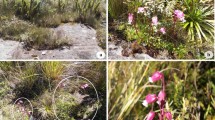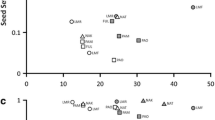Abstract
Paeonia delavayi is a wild tree peony species endemic to high-altitude regions in southwestern China. Recent agricultural land expansion, however, not only causes its dwindling population size, but also poses a severe threat to its long-term persistence. Since our knowledge of the reproductive biology of P. delavayi is very limited, and some management misconceptions have further exacerbated the already worrisome situation, the aim of the present study is to provide some scientific evidence regarding habitat preference and breeding system of P. delavayi, and to help correct some management misconceptions. Specifically, morphological traits of P. delavayi populations growing in two different habitats (i.e., the open area versus forest understory), including basal stem diameter, plant height and flower numbers per plant, were measured and compared with each other. A range of floral manipulation experiments was further conducted to study the extent of self-compatibility and pollen limitation. The results showed that P. delavayi preferred the open habitat over forest understory as it generally grew bigger with thicker stems, and produced a higher number of flowers in the former habitat. Therefore, the open habitat should receive immediate priority for conservation action instead of being converted to agricultural land; also, P. delavayi is pollen limited, as evidenced by the fact that experimental flowers receiving supplemental non-self pollen generally displayed elevated seed production than flowers subjected to other treatments (e.g., non-supplemental self pollen, non-supplemental non-self pollen and supplemental self pollen), which is consistent with reported observations that alpine plants are more likely to be pollen-limited than lowland plants. We suggest that human intervention might be necessary to guarantee the long-term persistence of P. delavayi as harsh alpine environment, intense competition for pollinators and different anthropogenic perturbations co-limit its reproductive success.
Similar content being viewed by others
References
Aizen MA, Harder LD (2007) Expanding the limits of the pollen-limitation concept: effects of pollen quantity and quality. Ecology 88: 271–281. DOI: 10.1890/06-1017
Arroyo MTK, Primack R, Armesto J (1982) Community studies in pollination ecology in the high temperate Andes of central Chile. I. Pollination mechanisms and altitudinal variation. American Journal of Botany 69(1): 82–97. DOI: 10.2307/2442833
Ashman TL, Knight TM, Steets JA, et al. (2004) Pollen limitation of plant reproduction: Ecological and evolutionary causes and consequences. Ecology 85(9): 2408–2421. DOI: 10.1890/03-8024
Brandt JS, Butsic V, Schwab B, et al. (2015) The relative effectiveness of protected areas, a logging ban, and sacred areas for old-growth forest protection in southwest China. Biological Conservation 181: 1–18. DOI: 10.1016/j.biocon.2014.09.043
Buchmann SL, Nabhan GP (1996) The forgotten pollinators. Island Press, Washington DC, USA.
Buide ML (2006) Pollination ecology of Silene acutifolia (Caryophyllaceae): floral traits variation and pollinator attraction. Annals of Botany 97(2): 289–297. DOI: 10.1093/aob/mcj032
Burd M (1994) Bateman principle and plant reproduction-the role of pollen limitation in fruit and seed set. The Botanical Review 60(1): 83–139. DOI: 10.1007/BF02856594
Burd M, Ashman TL, Campbell DR, et al. (2009) Ovule number per flower in a world of unpredictable pollination. American Journal of Botany 96(6): 1159–1167. DOI: 10.3732/ajb.0800183
Campbell DR (1985) Pollinator sharing and seed set of Stellaria pubera: Competition for pollination. Ecology 66(2): 544–553. DOI: 10.2307/1940403
Charlesworth D, Charlesworth B (1987) The effect of investment in attractive structures on allocation to male and female functions in plants. Evolution 41(5): 948–968. DOI: 10.2307/2409184
Cohen O, Shmida A (1992) Red Data Book of Israel Plants. Rare and Endangered Species of Upper Galilee. Nature Reserve Authority and the Society for the Protection of Nature, Israel (In Hebrew).
Cosacov A, Nattero J, Cocucci AA (2008) Variation of pollinator assemblages and pollen limitation in a locally specialized system: the oil-producing Nierembergia linariifolia (Solanaceae). Annals of Botany 102(5): 723–734. DOI: 10.1093/aob/mcn154
Cunningham SA (2000) Depressed pollination in habitat fragments causes low fruit set. Proceedings of the Royal Society B 267(1448): 1149–1152. DOI: 10.1098/rspb.2000.1121
Feng GM (1992) Paeonia lutea: China Plant Red Data Book-Rare and Endangered Plants. Science Press, Beijing.
Fulkerson JR, Whittall JB, Carlson ML (2012) Reproductive ecology and severe pollen limitation in the polychromic tundra plant, Parrya nudicaulis (Brassicaceae). PLoS One 7(3): e32790. DOI: 10.1371/journal.pone.0032790
Garcia-Camacho R, Totland Ø (2009) Pollen limitation in the alpine: a meta-analysis. Arctic, Antarctic and Alpine Research 41(1): 103–111. DOI: 10.1657/1523-0430-41.1.103
Gong X, Pan YZ, Yang ZY (2003) The diversity and value of Paeonia delavay. Acta Botanica Boreali-Occidentalia Sinica 23(2): 218–223. (In Chinese).
Haig D, Westoby M (1988). On limits to seed production. The American Naturalist 131(5): 757–759. DOI: 10.1086/284817
Herrera CM (1995) Microclimate and individual variation in pollinators: flowering plants are more than their flowers. Ecology 76(5): 1516–1524. DOI: 10.2307/1938153
Hocking B (1968) Insect-flower associations in the high arctic with special reference to nectar. Oikos 19(2): 359–387. DOI: 10.2307/3565022
Hong DY, Pan KY (1999) Taxonomical history and revision of Paeonia sect. Moutan (Paeoniaceae). Acta Phytotaxonomica Sinica 37(4): 351–368. (In Chinese).
Hong DY, Pan KY (2005) Notes on taxonomy of Paeonia sect. Moutan DC. (Paeoniaceae). Acta Phytotaxonomica Sinica 43(7): 169–177. (In Chinese)
Hothorn T, Bretz F, Westfall P (2008) Simultaneous inference in general parametric models. Biometrical Journal 50(3): 346–363. DOI: 10.1002/bimj.200810425
Kevan PG (1972) Insect pollination of high arctic flowers. Journal of Ecology 60(3): 831–847. DOI: 10.2307/2258569
Knight TM, Steets JA, Vamosi JC, et al. (2005) Pollen limitation of plant reproduction: pattern and process. Annual Review of Ecology, Evolution, and Systematics 36(9): 467–497. DOI: 10.1146/annurev.ecolsys.36.102403.115320
Knight TM, Steets JA, Ashman TL (2006) A quantitative synthesis of pollen supplementation experiments highlights the contribution of resource reallocation to estimates of pollen limitation. American Journal of Botany 93(2): 271–277. DOI: 10.3732/ajb.93.2.271
Larson BMH, Barrett SCH (2000) A comparative analysis of pollen limitation in flowering plants. Biological Journal of the Linnean Society 69(4): 503–520. DOI: 10.1006/bijl.1999.0372
Lavergne S, Thompson JD, Garnier E, Debussche M (2004) The biology and ecology of endemic and widespread plants: a comparative study of trait variation in 20 congeneric pairs. Oikos 107(3): 505–518. DOI: 10.1111/j.0030-1299.2004.13423.x
Lennartsson T (2002) Extinction thresholds and disrupted plant pollinator interactions in fragmented plant populations. Ecology 83(11): 3060–3072. DOI: 10.1890/0012-9658(2002) 083[3060:ETADPP]2.0.CO;2/abstract
Li CH, Du H, Wang LS, et al. (2009) Flavonoid composition and antioxidant activity of tree peony (Paeonia section Moutan) yellow flowers. Journal of Agricultural and Food Chemistry 57(18): 8496–8503. DOI: 10.1021/jf902103b
Li JJ (1999) Chinese tree peony and herbaceous peony. Beijing: China Forestry Publishing House.
Li K, Zheng BQ, Wang Y, et al. (2012) Numeric dynamics of natural populations of Paeonia delavayi (Paeoniaceae). Chinese Journal of Plant Ecology 36(6): 522–529. (In Chinese). DOI: 10.3724/SP.J.1258.2012.00522
Li K, Zheng BQ, Wang Y, et al. (2013) Flowering characteristics and breeding System of Paeonia delavayi. Journal of Northeast Forestry University 41(1): 63–67. (In Chinese).
Lloyd DG, Venable DL (1992) Some properties of natural selection with single and multiple constraints. Theoretical Population Biology 41(1): 90–110. DOI: 10.1016/0040-5809(92)90051-T
Ma CL, Moseley RK, Chen WY, et al. (2007) Plant diversity and priority conservation areas of Northwestern Yunnan, China. Biodiversity and Conservation 16(3): 757–774. DOI: 10.1007/s10531-005-6199-6
Ne’eman G (2003) To be or not to be-the effect of nature conservation management on flowering of Paeonia mascula (L.) Miller in Israel. Biological Conservation 109(1): 103–109. DOI: 10.1016/S0006-3207(02)00143-X
Ning CL, Jiang Y, Meng JS, et al. (2015) Herbaceous peony seed oil: a rich source of unsaturated fatty acids and γ-tocopherol. European Journal of Lipid Science and Technology 117(4): 532–542. DOI: 10.1002/ejlt.201400212
Powell MC, Bunt AC (1978) The effect of temperature and light on flower development in Pelargonium domesticum. Scientia Horticulturae 8(1): 75–79. DOI: 10.1016/0304-4238(78)90072-9
Rathcke B (1988) Interactions for pollination among coflowering shrubs. Ecology 69(2): 446–457. DOI: 10.2307/1940443
Shi Q, Zhou L, Wang Y, et al. (2015) Transcriptomic analysis of Paeonia delavayi wild population flowers to identify differentially expressed genes involved in purple-red and yellow petal pigmentation. PloS one 10(8): e0135038. DOI: 10.1371/journal.pone.0135038
Totland Ø (1993) Pollination in alpine Norway: Flowering phenology, insect visitors, and visitation rates in two plant-communities. Canadian Journal of Botany 71(8): 1072–1079. DOI: 10.1139/b93-124
Wang LY (1997) Pictorial record of Chinese tree peony varieties. China Forestry Publishing House, Beijing.
Willson MF (1979) Sexual selection in plants. The American Naturalist 113(6): 777–790. DOI: 10.1086/283437
Zimmerman M, Pyke GH (1988) Reproduction in Polemonium: assessing the factors limiting seed set. The American Naturalist 131(5): 723–738. DOI: 10.1086/284815
Zhou SL, Zou XH, Zhou ZQ, et al. (2014) Multiple species of wild tree peonies gave rise to the ‘king of flowers’, Paeonia suffruticosa Andrews. Proceedings of the Royal Society B 281(1797): 20141687. DOI: 10.1098/rspb.2014.1687
Acknowledgments
This work was supported by China Special Fund for Forest Scientific Research in the Public Welfare (201204110), the National Natural Science Foundation of China (31460158), and the Middle Aged Academic and Technical Leader Project of Yunnan Province (2010CI016).
Author information
Authors and Affiliations
Corresponding author
Additional information
http://orcid.org/0000-0001-7753-9408
http://orcid.org/0000-0001-7028-2849
http://orcid.org/0000-0001-8657-3800
http://orcid.org/0000-0002-2868-9175
Rights and permissions
About this article
Cite this article
Li, W., Pan, Ww., Tan, R. et al. Loss of preferred habitat and pollen limitation threatens reproduction in a rare mountain Paeonia delavayi . J. Mt. Sci. 13, 2147–2154 (2016). https://doi.org/10.1007/s11629-016-4030-3
Received:
Revised:
Accepted:
Published:
Issue Date:
DOI: https://doi.org/10.1007/s11629-016-4030-3




